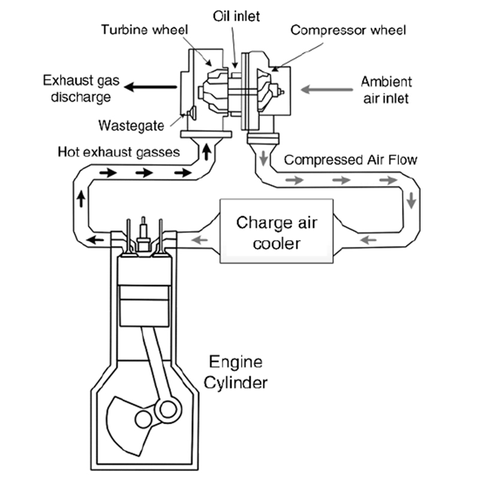Summary
This article mainly makes a brief introduction to the turbocharger, its principle, composition, use and installation on the engine. Through this article, we can learn what a turbocharger is, its application principle and internal structure.
Turbocharger Introduction
A turbocharger is actually an air compressor that compresses air to increase the amount of air intake, thereby increasing the power of the engine. It uses the inertial momentum of the exhaust gas discharged from the engine to drive the turbine in the turbine chamber, and the turbine drives the coaxial impeller, which presses the air sent by the air filter pipe to pressurize it into the cylinder. When the engine speed increases, the exhaust gas discharge speed and the turbine speed also increase synchronously, and the impeller compresses more air into the cylinder, and the pressure and density of the air increase to burn more fuel. Increase the fuel volume and adjust the engine accordingly. The speed can increase the output power of the engine.

Turbocharger Principle
The earliest turbochargers were used in sports cars or formula cars because their engines had very little power, and the use of turbochargers allowed the engine to gain more power.
The engine generates power by burning fuel in the cylinder. Since the amount of fuel input is limited by the amount of air in the cylinder, the power generated by the engine will also be limited. If the running performance of the engine is already at its best, we can only increase the amount of fuel by compressing more air into the cylinder to achieve the purpose of increasing the output power, thereby improving the engine's working ability. Therefore, under the current technical conditions, the turbocharger is the only mechanical device that can increase the output power of the engine without reducing the working efficiency.

Turbocharger composition
The turbocharger is mainly composed of a turbine chamber and a supercharger. The air inlet of the turbine chamber is connected with the exhaust manifold of the engine, and the exhaust port is connected with the exhaust pipe. The intake port of the supercharger is connected to the air filter pipe, and the exhaust port is connected to the intake manifold. The turbine and the impeller are respectively installed in the turbine chamber and the supercharger, and the two are coaxially rigidly connected.

Turbocharger effect
The main function of turbocharging is to increase the intake air volume of the engine through the turbocharger, thereby increasing the output power and torque of the engine. After an engine is equipped with a turbocharger, its maximum power can be increased by 40% or even higher. This also means that the same engine can produce more power after being supercharged, and the working efficiency of the engine can also be improved.
Turbocharger installation
Turbochargers are very delicate engine components, so they need to be assembled and disassembled with great care. And when assembling and disassembling, please confirm and replace the peripheral parts such as the engine and exhaust pipe, if not confirmed and replaced well, this will lead to abnormal use of the replaced turbocharger, which will not only damage the turbocharger will damage the engine. Most importantly, and please pay attention to safety during the update process to avoid accidents.
The following must be done when installing a turbocharger on an engine.
- Be sure to remove the sealing strips and covers of the oil inlet and outlet of the new turbocharger.
- Engine oil, oil filter, sealing ring, liner, etc. must be replaced with new ones.
- Confirm whether there are foreign objects, deformations, etc. in the oil inlet pipe, oil outlet pipe and joint bolts. Please clean them. You can clean them with an air gun or replace them with new ones.
- Make sure that there are no foreign objects (nuts, bolts, waste cloth and plastic, etc.) and oil stains inside the air filter, suction manifold, exhaust manifold, and suction pipe.
- In the case of damaged compressor impeller and loose nuts, please confirm whether there are foreign objects in the discharge pipe (nuts, bolts, waste cloth and plastic, etc.).

Article summary
Turbochargers are widely used in life, and they mainly appear in construction machinery engines and automobile engines to provide them with greater power. It can greatly increase the power and torque of the engine without increasing the engine displacement. Turbocharged engines are not only more fuel-efficient, but also reduce CO (carbon monoxide), CH (hydrocarbons) and PM (particulates) in emissions, making them more environmentally friendly.
The turbocharged engine is simple in structure, easy to install, and has wide technical adaptability. It can be applied from low speed to high speed, from two-stroke to four-stroke, and from small bore to large bore. And the noise of the turbocharged engine is smaller than that of the naturally aspirated engine.
FAQ
- What are the disadvantages of turbochargers?
The power output response lags behind. Generally, the improved turbocharger takes at least 2 seconds to increase or decrease the engine power output. After supercharging, the pressure and temperature of the engine are greatly increased when it is working, so the engine life will be shorter than that of an engine with the same displacement that has not been supercharged, and the mechanical properties and lubrication performance will be affected.
- Can I repair a turbocharger myself?
The precision of turbocharger rotor bearings is very high, and the working environment requirements for maintenance and installation are very strict. Therefore, when the turbocharger fails or is damaged, it should be repaired at a designated repair station instead of an ordinary repair shop. If you are confident enough in yourself, you can choose to repair it yourself.
- What are the characteristics of a turbocharger?
High temperature, high speed, high power, high torque, low emission.
View our turbocharger at wdpart: https://wdpart.com/collections/turbocharger
















